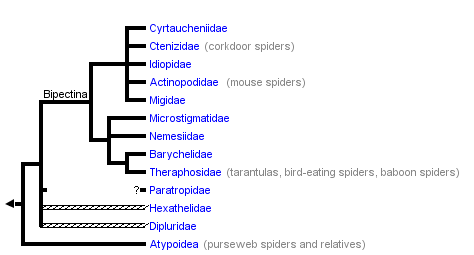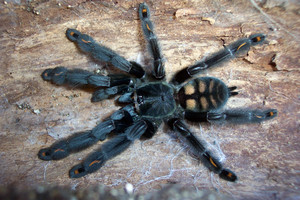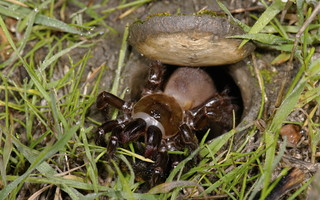Mygalomorphae
Tarantulas, trapdoor spiders & kin
Jason Bond and Marshal Hedin


This tree diagram shows the relationships between several groups of organisms.
The root of the current tree connects the organisms featured in this tree to their containing group and the rest of the Tree of Life. The basal branching point in the tree represents the ancestor of the other groups in the tree. This ancestor diversified over time into several descendent subgroups, which are represented as internal nodes and terminal taxa to the right.

You can click on the root to travel down the Tree of Life all the way to the root of all Life, and you can click on the names of descendent subgroups to travel up the Tree of Life all the way to individual species.
For more information on ToL tree formatting, please see Interpreting the Tree or Classification. To learn more about phylogenetic trees, please visit our Phylogenetic Biology pages.
close boxIntroduction
The mygalomorph spiders, including trapdoor spiders, tarantulas and their kin, is a moderately diverse group that includes more than 2,600 described species, classified in over 300 genera and 15 families. The group is a diverse assemblage of relatively large, long-lived (15-30 years), ground dwelling spiders that build a diverse array of silk constructs used for prey capture, shelter, and protection (Coyle 1986). Considered an ancient monophyletic group (Coddington & Levi 1991; Platnick & Gertsch 1976; Raven 1985), mygalomorphs retain several characteristics that are considered primitive for spiders (e.g., two pairs of book lungs, simple spinning structures, etc). Many mygalomorph taxa are dispersal-limited and regionally-endemic, and have long been favorites of biogeographers (e.g., Griswold & Ledford 2001; Platnick 1981). Mygalomorph lineages have a deep evolutionary history, as reflected in a rich fossil fauna that extends back to the lower Triassic (Selden & Gall 1992), with fossil representatives of several families dating to the mid-Cretaceous (see Eskov & Zonshtein 1990; Penney et al. 2003; Selden 2002). Recent molecular clock analyses suggest intra-familial divergences date to the Cretaceous (Hendrixson & Bond 2007), and inter-familial divergences may be as old as 300 Ma (Ayoub et al. 2007).
References
Ayoub NA, Garb JE, Hedin M, Hayashi CY. 2007. Utility of the nuclear protein-coding gene, elongation factor-1 gamma (EF-1γ), for spider systematics, emphasizing family level relationships of tarantulas and their kin (Araneae: Mygalomorphae). Molecular Phylogenetics and Evolution 42, 394-409.
Bond, J.E., Hedin, M., 2006. A total evidence assessment of the phylogeny of North American euctenizine trapdoor spiders (Araneae, Mygalomorphae, Cyrtaucheniidae) using Bayesian inference. Mol. Phylogen. Evol., in revision.
Coddington, J. A. and H. W. Levi. 1991. Systematics and evolution of spiders (Araneae). Annual Review of Ecology and Systematics 22:565-592.
Coyle, F.A., 1986. The role of silk in prey capture by nonaraneomorph spiders. In: Shear, W.A. (Ed.), Spiders: Webs, Behavior and Evolution. Stanford University Press, Stanford. pp. 269-305.
Dippenaar-Schoeman AS. 2002. Baboon and Trapdoor Spiders of Southern Africa: An Identification Manual Agricultural Research Council, Pretoria, South Africa.
Eskov, K., Zonshtein, S., 1990. First Mesozoic mygalomorph spiders from the Lower Cretaceous of Siberia and Mongolia, with notes on the system and evolution of the infraorder Mygalomorphae (Chelicerata:Araneae). N. Jb. Geol. Pal�ont. Abh. 178, 325-368.
Goloboff, P.A., 1993. A reanalysis of mygalomorph spider families (Araneae). Am. Mus. Novit. 3056, 1-32.
Griswold, C. Ledford, J., 2001. A monograph of the migid trap-door spiders of Madagascar, with a phylogeny of world genera (Araneae, Mygalomorphae, Migidae). Occ. Pap. Calif. Acad. Sci. 151, 1-120.
Hedin, M and J. E. Bond. 2006. Molecular phylogenetics of the spider infraorder Mygalomorphae using nuclear rRNA genes (18S and 28S): Conflict and agreement with the current system of classification. Molecular Phylogenetics and Evolution, 41, 454-471.
Hendrixson BE, Bond JE (2007) Molecular phylogeny and biogeography of an ancient Holarctic lineage of mygalomorph spiders (Araneae: Antrodiaetidae: Antrodiaetus). Molecular Phylogenetics and Evolution
Penney, D., Wheater, C.P., Selden, P.A., 2003. Resistance of spiders to Cretaceous-Tertiary extinction events. Evolution 57, 2599-2607.
Platnick, N.I., 1977. The hypochiloid spiders: A cladistic analysis, with notes on the Atypoidea (Arachnida, Araneae). Am. Mus. Nov. 2627, 1-23.
Platnick, N.I., 1981. Spider biogeography: past, present, and future. Revue Arachnologique 3, 85-96.
Platnick, N.I., Gertsch, W.J., 1976. The suborders of spiders: A cladistic analysis (Arachnida, Araneae). Am. Mus. Nov. 2607, 1-15.
Raven, R.J., 1985. The spider infraorder Mygalomorphae (Araneae): cladistics and systematics. Bull. Am. Mus. Nat. Hist. 182, 1-180.
Selden PA (2002) First British Mesozoic spider, from Cretaceous amber of the Isle of Wight. Palaeontology 45, 973-983.
Selden, P.A., Gall, J.-C., 1992. A Triassic Mygalomorph spider from the northern Vosges, France. Paleontology 35, 211-235.
Title Illustrations

| Scientific Name | Psalmopoeus irminia |
|---|---|
| Source | Psalmopoeus irminia - Venezuelan Suntiger |
| Source Collection | Flickr |
| ToL Image Use |
 This media file is licensed under the Creative Commons Attribution-NonCommercial-ShareAlike License - Version 2.0. This media file is licensed under the Creative Commons Attribution-NonCommercial-ShareAlike License - Version 2.0.
|
| Copyright | © 2003 B Smith |
| Scientific Name | Bothriocyrtum californicum |
|---|---|
| Location | San Diego, CA |
| Specimen Condition | Live Specimen |
| Identified By | Marshal Hedin |
| Behavior | prey capture from trapdoor |
| Sex | Female |
| ToL Image Use |
 This media file is licensed under the Creative Commons Attribution-NonCommercial License - Version 3.0. This media file is licensed under the Creative Commons Attribution-NonCommercial License - Version 3.0.
|
| Copyright |
© Marshal Hedin

|
About This Page
Jason Bond

East Carolina University, Greenville, North Carolina, USA
Marshal Hedin

San Diego State University, San Diego, California, USA
Correspondence regarding this page should be directed to Jason Bond at
bondja@ecu.edu
and Marshal Hedin at
mhedin@sciences.sdsu.edu
Page copyright © 1995 Jason Bond and Marshal Hedin
 Page: Tree of Life
Mygalomorphae. Tarantulas, trapdoor spiders & kin.
Authored by
Jason Bond and Marshal Hedin.
The TEXT of this page is licensed under the
Creative Commons Attribution-NonCommercial License - Version 3.0. Note that images and other media
featured on this page are each governed by their own license, and they may or may not be available
for reuse. Click on an image or a media link to access the media data window, which provides the
relevant licensing information. For the general terms and conditions of ToL material reuse and
redistribution, please see the Tree of Life Copyright
Policies.
Page: Tree of Life
Mygalomorphae. Tarantulas, trapdoor spiders & kin.
Authored by
Jason Bond and Marshal Hedin.
The TEXT of this page is licensed under the
Creative Commons Attribution-NonCommercial License - Version 3.0. Note that images and other media
featured on this page are each governed by their own license, and they may or may not be available
for reuse. Click on an image or a media link to access the media data window, which provides the
relevant licensing information. For the general terms and conditions of ToL material reuse and
redistribution, please see the Tree of Life Copyright
Policies.
- Content changed 14 September 2008
Citing this page:
Bond, Jason and Hedin, Marshal. 2008. Mygalomorphae. Tarantulas, trapdoor spiders & kin. Version 14 September 2008 (under construction). http://tolweb.org/Mygalomorphae/2641/2008.09.14 in The Tree of Life Web Project, http://tolweb.org/









 Go to quick links
Go to quick search
Go to navigation for this section of the ToL site
Go to detailed links for the ToL site
Go to quick links
Go to quick search
Go to navigation for this section of the ToL site
Go to detailed links for the ToL site